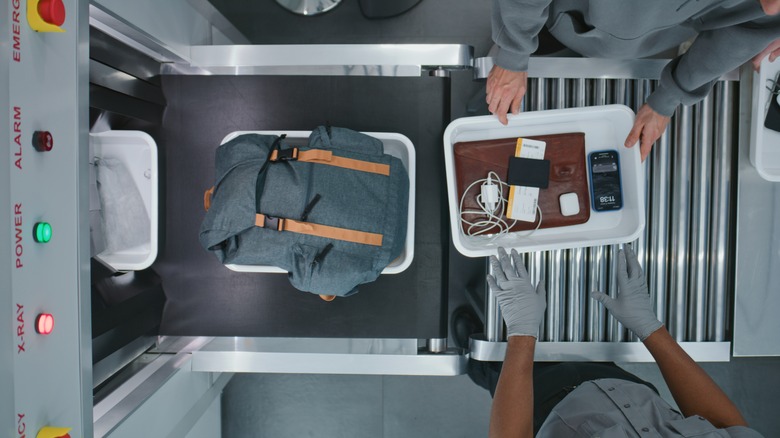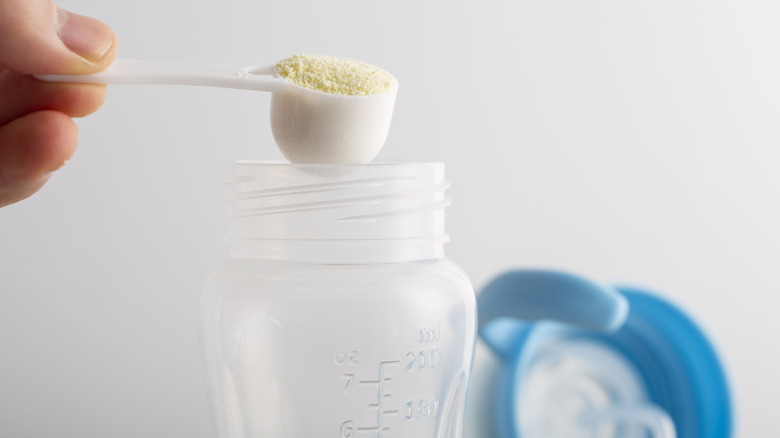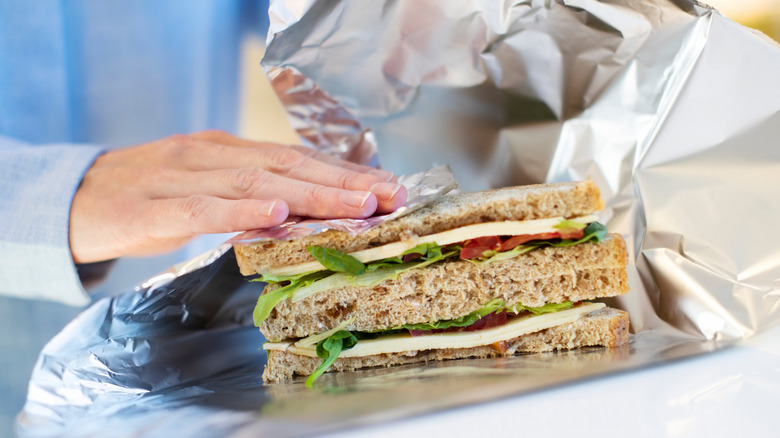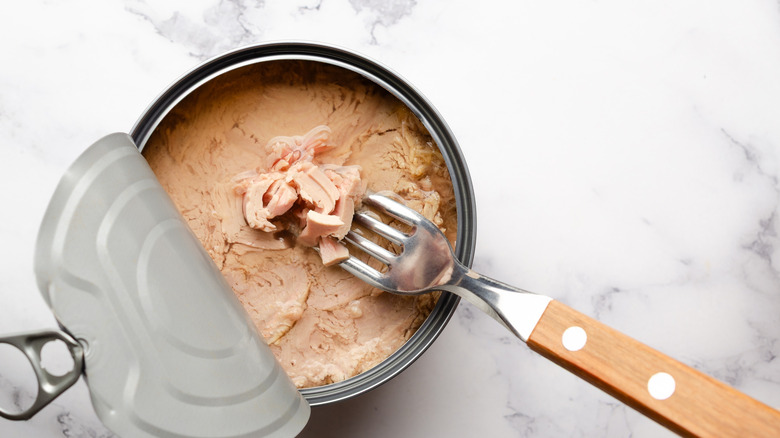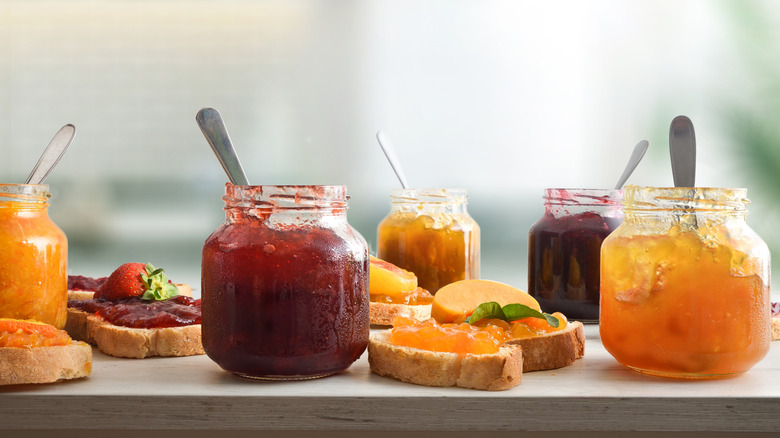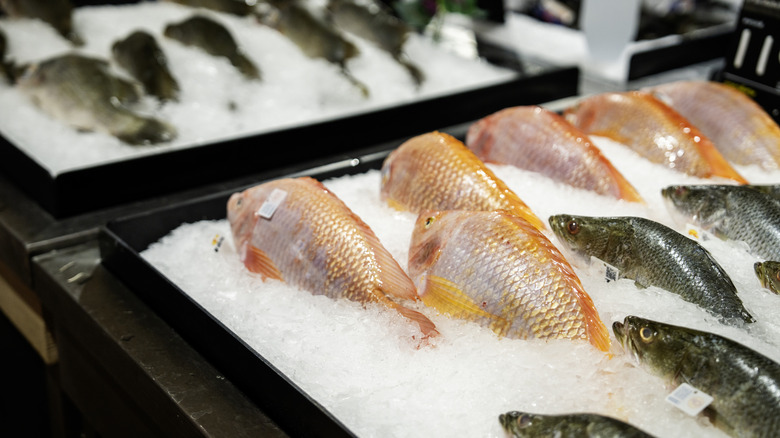The Unexpected Foods That Will Almost Always Get Flagged By TSA
As if it wasn't enough for the TSA to come for your kid's stuffed animal, the novel that you were innocently reading, or even your hard-earned cash, now they want your snacks. They don't want to eat your snacks (okay, maybe they do); they want to confiscate them for having a potentially villainous purpose. Are we talking about Chili Cheese Fritos because they're so criminally awful? No, but they can have those. We're talking about things like food wrapped in foil, baby formula, or protein powder that resembles cocaine, sweet treats like honey and jam, and goopy foods like the malleable and devious hummus.
To be fair, such TSA-disapproved food choices aren't random. Many foods that will get flagged by the TSA need to go in 100-milliliter containers even if they aren't "liquid" because they can still conform to the shape of an object. Other foods, like frozen food, need to be packed in ice, which melts and produces no-no liquid. Other items like aluminum foil-wrapped sandwiches will get flagged because the foil interferes with airport scanners. At the very least, we all know about the absolutely banned, non-food items like swords and box cutters, cattle prods, and hand grenades — you know, typical vacation stuff.
Thankfully, the TSA has a handy food and drink list on its website to help clear up confusion about potentially troublesome food items, although it doesn't answer every question. In the end, alcohol over 140 proof is the only liquid refreshment outright banned, no questions asked, but plenty of other items come with stipulations that need to be followed unless a passenger wants to draw the TSA's ire. Some foods are so restriction-laden that they might as well be functionally banned anyway.
The intricacies of getting baby food through security
Traveling with babies can be extremely difficult. They need their food when they need it, and they definitely can't be limited to the TSA's 3-1-1 rule. The rule's name stands for 3 ounces (about 100 milliliters), 1 bag (quart-sized), 1 person (one bag per person), and refers to the ever-troublesome carry-on liquid restrictions that we're all familiar with by now. Thankfully, baby food can bypass this rule, but passengers with babies may still face extra screening, and in rare cases, formula could be discarded if it cannot be cleared.
Generally speaking, you can break every 3-1-1 rule for babies. You can carry liquid in quantities greater than 100 milliliters, you don't need quart-sized bags, you can carry ice or ice packs for breast milk, and your baby doesn't need to be present when you go through security. But the TSA, on its website, says that you have to explain everything ahead of time when you start passing through security. You should also use bottles instead of baggies, although you might be subject to a deeper search anyway. The same applies to toddler foods like those squeezy puree packets.
Parents headed through airport security with unmixed, powdered baby formula, however, beware. The same goes for folks with protein powder. In a nutshell, powder of any kind could be taken for drugs or explosives. Protein powder weighing 12 ounces or more has to undergo a separate security screening in a separate bin and might be opened and scrutinized. In fact, the TSA directly recommends putting such items in checked bags, not carry-ons. And while the TSA doesn't say the same thing for powdered baby formula, it'd be naive to think that such an item could pass through security without the possibility of causing hang-ups.
Foil-wrapped food might trigger a TSA search
No matter all the precautions that the TSA takes to ensure that passengers know what is and isn't allowed in carry-ons, and no matter the giant food list on the TSA website, some items are going to fall through the cracks. Not once in the TSA's list does it mention aluminum foil, for instance. It's not that foil is banned, but it still might get you flagged by the TSA. It's also not that the sandwich, burrito, kebab, etc., inside the foil is banned. It's because foil creates an indirect technological problem.
The TSA's potential issue with foil relates to airport security scanners. Airport scanners can use a variety of scans, like ionizing radiation scans, millimeter wave scans, and X-rays. Aluminum doesn't totally block these scans, but it does affect them — even a thin layer of foil. When security scanners try to penetrate foil, their screens display a slab of brightness or darkness. This is going to raise the alarm for the TSA, at least because they don't know what that slab of brightness or darkness is. So, the TSA has to take your bag aside, ask you to open it, poke around a bit, etc. This means delays, stress, and the discomfort of exposing personal items in public.
To avoid all such unnecessary complications, passengers can just wrap their food in something different, like plastic wrap — if you're taking the food from home, that is. If you bought some food to-go on the way to the airport, you might have to transfer it to another container or eat it before heading into security.
Canned items could get flagged
It'd be a little weird to peel back the lid of a can of tuna and start spooning it out on a flight. The smell alone might garner death stares. But setting aside social norms, sure, you could do it. You could pop open any can of food on a flight, like corn, refried beans, fruit, nuts, or even soup, but you might not be able to take such canned foods on your flight to begin with. The problem is dual-fold: liquid and metal.
As the TSA once again says on its giant list of food items, it's not that canned foods are outright banned; it's that they've got to adhere to the 3-1-1 rule. Tuna, for instance, is suspended in liquid. If the liquid is over 100 milliliters, then it's a no-go. You could still follow the 3-1-1 rule by carrying a single, quart-sized bag through airport security with your hand lotion, conditioner, face scrub, and a tiny plastic bottle of tuna suspended in tuna juice like a shot of fish. But well, you do you.
Plus, canned food comes in cans made from metal, so we come across the same problem as with aluminum foil. Nowadays, many food cans in the U.S. are made from steel, either stainless (chemically inert) or coated in a polymer. They also might be plated with tin. Other cans, like coffee cans, usually contain aluminum. The thickest of them will appear like a dark splotch on the TSA's screens, though all of these cans could catch the TSA's attention. Unless you've got a can made of solid gold, platinum, or tungsten — metals undetectable to X-rays — it's going to get flagged by the TSA.
The trouble with jams, yogurt, salsa, and other malleable substances
Now we come to a vast catch-all type of food alluded to many times already: the malleable semi-solid. The TSA's potential problem with such foods has nothing to do with the food itself. Any substance into which you can insert an object and which will conform to the shape of that object is restricted to itty-bitty 100-milliliter containers. This means jam, jelly, honey, yogurt, gravy, spreadable cheese, liquid chocolate, salsa, sauce, ice cream, peanut butter, wet pet food, salad dressing — all of it. And don't think tales of your grandma's lovingly crafted, homemade, orange marmalade will sway the TSA. There's still a good chance they could chuck it in the trash.
All such liquid-like substances have to conform to the TSA's 3-1-1 rule. We've all seen those tiny, single-serving jam jars that make great gifts or souvenirs. Those are fine if they're 100 milliliters or smaller. Otherwise, the malleable semi-solid in question has to be kept in a quart-sized bag along with your shampoo and tuna juice shot. It's up to the reader to determine whether or not it's worth it to transfer 100 milliliters of their favorite gravy to a tiny bottle just to take it in a carry-on during a flight.
And lest the reader think this amounts to an absurd rule, we point your attention to all the bizarre ways that folks have tried to smuggle guns and drugs onto flights. Disassembled guns stuck into jars of peanut butter are not beyond ne'er-do-wells, ludicrous as it sounds. But concealed gun or not, peanut butter and other malleable foods are going to catch the TSA's attention.
Frozen items need to be encased in dry, not regular, ice
Finally, we come to frozen fish, meat, and vegetables – frozen food of any type, really. As before, the issue isn't with the food itself, but with the liquid. If you use regular ice to pack your frozen food, the ice is going to melt. If you use ice packs, they'll produce condensation as they melt and soften. Even if, for some reason, you stick a store-bought pack of frozen peas in your carry-on, the peas will thaw and condense. The same goes for, let's say, a giant chunk of venison tenderloin procured on a hunting trip. In the end, if there's any liquid at the bottom of your packaging container, then the item won't be allowed on the flight. Everything has to be totally frozen solid.
Thankfully, there's a workaround for this particular ice-related issue. The Federal Aviation Administration allows you to pack up to 5.5 pounds of dry ice per passenger to keep frozen items cold. Since dry ice is made of carbon dioxide, its packaging needs to be properly ventilated to release gas. The dry ice also has to be labeled "dry ice" or "carbon dioxide, solid." But even then, passengers have to receive direct approval from an airline before taking their dry ice on board. And even then, the TSA reserves the right to override any such decisions and stop your food from getting on board a flight. It's probably best to leave your whole, frozen catfish at home.
